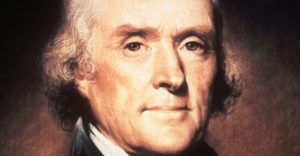Islam’s roots in America go back to the Founding Fathers
US President Trump’s ban on immigrants and refugees presupposes that Islam is a relatively new phenomenon in America and that Muslim Americans are mostly recent migrants.
But, Islam has long history in America that stretches back to the days of the founding fathers.
Muslim Americans are intertwined with the nation’s earliest modern history. This is not well-known, possibly because the Muslim population of the US has nearly always been small.
 But Muslims feature in some of the nation’s most totemic eras and social transformations – including the history of slavery and emancipation, in the formation of the US Constitution and in the black civil rights movement.
But Muslims feature in some of the nation’s most totemic eras and social transformations – including the history of slavery and emancipation, in the formation of the US Constitution and in the black civil rights movement.
The most visible presence of Islam in America at the time of the Founding Fathers was in the words and actions of the founders themselves, who deliberately included Islam as they established the principles of liberty.
James Hutson, of the Library of Congress, says that the Founding Fathers included Islam in their notion of a free secular nation.
“The Founding Founders of this nation explicitly included Islam in their vision of the future of the republic. Freedom of religion, as they conceived it, encompassed it,” he said.
Thomas Jefferson, who famously owned a copy of the Koran, campaigned for religious freedom and demanded “recognition of the religious rights of the ‘Mahamdan,’ the Jew and the ‘pagan’.”
Whether or not a Muslim could one day be president of the United States was also a question discussed by the Founding Fathers in finalising the US Constitution.
In 1788, those who opposed ratification warned that Article VI of the Constitution allowed for the possibility that one day, “in the course of four or five hundred years,” a Muslim could become president of the United States.
Article VI states that “no religious Test shall ever be required as a Qualification to any Office or public Trust under the United States”.
The Constitution, obviously, was eventually ratified and the clause stayed in.
There is even a bas-relief statue of the Prophet Mohammed on the north wall of US Supreme Court. It was built in 1935 but’s genesis lies much earlier.
In his book The Cultural Roots of American Islamicism, Timothy Marr says the “larger-than-life representation of the Prophet Muhammad” is situated “between Charlemagne and Justinian as one of eighteen great law givers of history”.
Many were educated and literate in Arabic but there were widespread forced conversions to Christianity.
Despite the massive influx of Muslims from the Atlantic slave trade, by the end of the 19th century Islam had almost disappeared.
At the same time that Islam was fading among communities of slaves and former slaves, millions of immigrants began arriving on America’s shores toward the end of the 19th and especially the early 20th centuries.
They included tens of thousands from Muslim-majority countries in the Middle East, South and Central Asia, and Eastern Europe. They were spurred in part by the Industrial Revolution that erupted once America finally emerged from the ashes of the Civil War and Reconstruction era.
America’s first mosque was built in Chicago in 1893 as part of the “Street in Cairo” attraction at the World’s Columbian Exhibition in Chicago.
A second mosque was not built in the US until 2921 in Highland Park, Michigan.
The early 20th century saw Muslim immigrant communities in America beginning to establish small, local community organisations across the country.
At the same time, historians say, African Americans also began to embrace Islam in the 1920s and 30s partially in response to the radical dislocations and racism they experienced prior to and during the Great Migration – the movement of disenfranchised southerners to industrial regions in the North.
Islam played a significant part in the black civil rights movement.
Several of these African-American Muslim associations had a significant impact on the face of Islam in America and they included Marcus Garvey’s Negro World, the newspaper the United Negro Improvement Association.
The 9/11 terror attacks in 2001 were a pivotal moment in the history of Islam in the US.
They amounted to the most serious attack on American soil since Pearl Harbour.
Although Muslim religious leaders in the US immediately denounced the attacks as un-Islamic, many Americans began to fear and distrust their Muslim neighbours. The FBI reported a 1,600 per cent increase in anti-Muslim hate crime.
Muslim Americans are now at the centre of some of the US’ most contentious issues: foreign policy, national security, terrorism, inclusion, religious liberty, and American identity.
The rise of ISIS has triggered a resurgence in the global jihadist movement and consequently there has also been an increase in Islamophobia.
Mosques have been vandalised, innocent people have been harmed, and the Trump Administration is attempting to ban Muslims from certain countries entering the US.
Despite their long and rich history as part of American society going all the way back to the founding of the nation and their significant contribution, many Muslim Americans are now being treated as unwelcome foreigners.
Laurie Nowell
AMES Australia Senior Journalist












